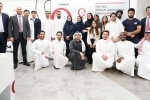
Countries throughout the Middle East face increasing environmental challenges: loss of wildlife, land degradation, poor air quality, and declining water resources are just some of the many examples. The region is also highly exposed to the accelerating impacts of climate change, including heat waves and floods, as seen in the region-wide floods of April 2024.
AI can help respond to these challenges. It is already top of mind for leaders in the environmental sector because the vast data sets that the sector generates and complex connections among its different domains lend themselves to AI applications. AI is being tested to forecast the impact of human activities on air or water quality and to simulate the impact of potential interventions, helping authorities identify and implement the best ones. It is already used to optimize water distribution and manage desalination more efficiently, as well as to predict water demand patterns and manage irrigation systems in agriculture more sustainably.
However, AI’s tremendous potential cannot be achieved by implementing standalone use cases. Environment ministries and agencies need to integrate AI across their entire operations and business models in a cohesive and systematic way. In other words, they need to transform into “Cognitive Environment” agencies.
These would be built on three pillars:
While quick-win use cases can, and should, be pursued to achieve early impact, building a Cognitive Environment Agency or ministry requires much more than that. Studies show that 70% to 80% of AI projects fail, primarily due to lack of a comprehensive plan that tackles all prerequisites for success.
For environmental agencies, the AI journey should start by setting a clear vision and tangible objectives that span the three pillars of cognitive transformation. A roadmap of use cases should then be developed to achieve each of the defined objectives, taking into account data quality and sufficiency. The roadmap should be carefully phased so that each new application builds on the data and applications previously rolled out, to maximize cross-app communication and reduce development cost. While defining use cases, agencies should take special interest in identifying the new business offerings and revenue streams that AI can unlock for them; that could include, for instance, selling accurate and granular climate analytics to urban planners or developers. New capabilities and skills will also be needed. These should be identified and developed or acquired, and agencies will need to reshape their organization to incorporate them effectively.
AI is a costly business; charting a clear path for this transformation is the only way to fully harness its power, and to avoid wasting time and money on failed efforts.
The environment sector in the Middle East is ripe for a revolutionary change: ministries and agencies across the region have been collecting environmental data for a long time. AI provides the opportunity to put that data to practical use along a wide range of challenges, thereby leapfrogging into the world’s first cognitive environmental model – and making a decisive contribution to improving the environmental outlook both in the region and globally.
This article originally appeared in Inc Arabia, December 2024.
Contact us























Menu